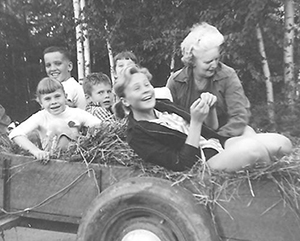
Preserving Family Photos
Fall 2015, Vol. 47, No. 3 | Your Family Archives
By Mary Lynn Ritzenthaler
 From school pictures to photographs of ancestors, almost everyone has treasured family photos that, in the face of natural or other disasters, are among the items people most want to save.
From school pictures to photographs of ancestors, almost everyone has treasured family photos that, in the face of natural or other disasters, are among the items people most want to save.
In early days, having a photographic likeness taken was a special event for which people dressed in their best clothing. Modern pictures record everything from beloved pets and birthday parties to graduations.
Photographs in family collections can range from daguerreotypes and tintypes to modern digital prints and electronic files. The life expectancy of photographs varies, depending on their type and the ways in which they have been processed, stored, and handled.
Some photographs are unstable because of the materials used to produce them. For example, the dyes (cyan, magenta, and yellow) in color photographs can fade, shift, or discolor. Since cyan fades more quickly than the other dyes, old images can often appear red. Also, photographs that were not thoroughly washed during chemical processing can have yellow or brownish stains.
While digital images are not susceptible to fading or staining, they are susceptible to loss when problems with computers and hard drives make files inaccessible. Preserving digital images is totally dependent on having secure systems to manage and retain files.
Regardless of the age or condition of family photographs, your goal is to do no harm and to help ensure preservation for future generations. Tips for preserving photographs are much the same as those for preserving paper documents:
Storage
Store photographs in cool, dry areas. Damp conditions can encourage the growth of mold, attract insects, and cause photographs to curl or to stick together. Avoid hot attics or damp basements or garages. Hot storage conditions can speed deterioration, resulting in staining, discoloration, and embrittlement.
Handling:
Do not touch the surfaces of prints; fingerprints can cause permanent stains on all types of photographs. Wear cotton or nitrile gloves! To avoid tears and breaks, handle all photographs and photo mounts gently with two hands, or lift and support them in a folder or on a piece of mat board.
Make sure your hands are clean (lotions can leave stains), and avoid food and drink around the photos. Do not force rolled photographs open, which could cause them to crack. Do not mend photographs with any kind of glue or tape. Do not fold, cut, or trim original photographs or remove them from their mounts. If handling the photograph seems to be causing damage, stop and seek help.
Housing:
Small groups of photographs of the same size and type—such as black-and-white prints or color photographs—can be kept together in small groups within folders or envelopes within boxes. Use preservation-quality folders and boxes that are large enough to fully enclose and support the photographs. Avoid using acidic cardboard shoe boxes! Photographs in poor condition or that have special value can be individually stored in stable plastic sleeves made from preservation-quality polyester or polyethylene. Large photographs, such as panoramas, should be stored flat if possible.
Captioning:
Avoid ink and markers around photographs. You can lightly write identifying information on the backs of some paper prints. Not all paper used for photos will accept pencil. In that case, write captions on the photo enclosures.
Display and Sharing:
Photographs—especially color and digital prints—can fade if exposed to light for long periods. All types of light will cause damage, though sunlight and fluorescent light are the quickest to cause changes. To avoid light damage, store photographs in the dark, and limit long-term display of the originals. Print a digital scan for display purposes, and use a scanner with a glass platen that is larger than your items. Do not use auto feed. For additional information on this topic, see: www.archives.gov/preservation For help finding a photograph conservator, see www.conservation-us.org/membership/find-a-conservator#.
Find more information on this topic at www.archives.gov/preservation.
Mary Lynn Ritzenthaler is chief of the National Archives Conservation Laboratory.